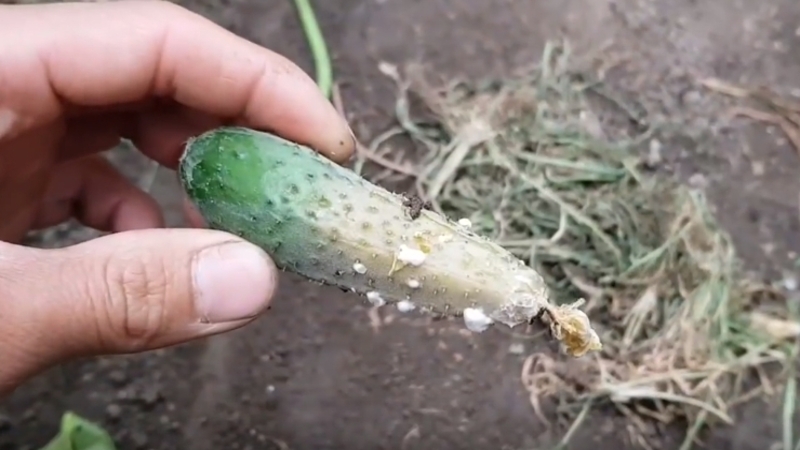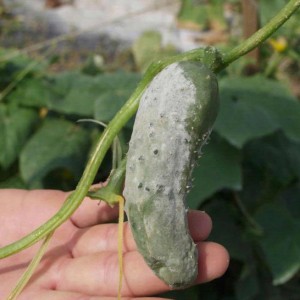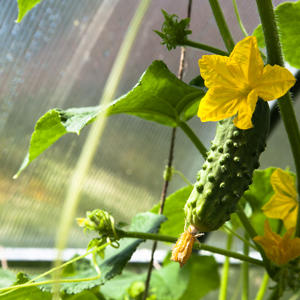Why does gray rot appear on cucumbers and how to deal with it
Cucumbers very often exposed to such a disease as gray rot. If you find light brown spots on your plantings, you should be wary - perhaps this is rot. In this article we will figure out what kind of disease it is, why it can occur and how to treat it.
The content of the article
What is this disease
Cucumber gray rot is a bacterial and fungal disease. The causative agent is the fungus Botrytis cinerea. It affects a large number of garden crops. Carried by insects, air currents, birds and garden tools.
The fungus can enter the plant through wounds from mechanical damage or through the stigma of the flower pistil. In the second case, the flowers quickly die, and the entire crop is lost.
The first signs of infection are the appearance of slippery spots of light brown color on the stem or leaves... They have a loose structure and eventually become covered with a gray fluffy bloom. Under the lesions, the plant rots and gradually dies.
The photo shows a cucumber with gray rot.

The fungus is able to tolerate winter in soil or on a greenhouse frame in the form of sclerotia.
Why is the disease dangerous?
After infection, the fungus begins to germinate, increasing its mycelium more and more. In parallel with this, toxic enzymes are produced, which are distributed throughout the plant. Neighboring healthy tissue also begins to stain and rot.
If the stem is affected, then the flow of water through the vessels is disturbed, and the cucumber is experiencing an acute shortage of nutrients and moisture.
Cucumbers significantly reduce their yield from gray rot. With severe damage, the plant completely dies.
Reasons for the appearance of gray rot on cucumbers
The main factors of infection can be both favorable natural conditions for the development and reproduction of fungi, and agrotechnical mistakes of the gardeners themselves.
Here is a list of possible reasons:
- High humidity (90%).
- The ideal temperature for the development of the fungus is 16-17 degrees.
- Sudden temperature changes.
- Strong drafts.
- Lack of ventilation in the greenhouse.
- Dense plantings.
- Watering with cold water.
- Lack of fertilizer.
- Excessive application of nitrogen-containing dressings.
- Failure to comply with crop rotation.
- Mechanical, chemical and thermal damage to plant tissue.
- Using untreated seeds. Lack of regular weeding and cleaning in the greenhouse.
- Lack of disinfection of the soil and the inner surface of the greenhouse.
- Loss of turgor (water pressure).
With the improvement of the microclimate in the greenhouse, the development of the disease stops. To do this, it is enough to establish ventilation, raise the temperature to 25 degrees and lower the humidity to 80%.
To get rid of the fungus with such measures, however, will not work. An integrated approach is needed.
In open ground, natural climatic conditions are dangerous. Frosts, sudden temperature changes, cold rains and even animals - all this contributes to the general weakening of the plant and its infection.
Read also:
How to deal with tomato top rot in a greenhouse.
Why is the "Marble" pumpkin so popular among farmers?
What to do if white spots appear on the leaves of tomatoes in the greenhouse.
How to fight
When the first signs of the disease are detected, it is necessary to stop watering and feeding, ventilate the greenhouse and carefully examine all the cucumbers.
Diseased leaves should be removed, and heavily affected plants should be pulled out and burned. This is to prevent the mushroom from spreading to other crops.
Then you can use various methods at your discretion.
Agrotechnical techniques
Seedlings with signs of gray rot are usually destroyed immediately. Adult plants, of course, I want to save. To do this, make a healing pruning: the lower leaves are cut off and laid on the ground, sprinkled with soil with "Trichodermin" on top.
It is also very helpful to add peat, ash, chalk or sawdust to the topsoil around the infected cucumbers. They need to be brought in to a depth of 4-5 centimeters. Only this must be done carefully so as not to damage the root collar.
Ready-made preparations
Modern means of combating diseases are very effective and can destroy the fungus quite quickly. But chemical agents can cause some harm: disrupt the microflora of the soil, burn the plant, etc. Therefore, you must strictly follow the instructions on the package.
Proven Chemicals:
- "Khom" - copper oxychloride.
- "Rovral" - in the composition of 50% iprodion.
- Euparen Multi is a moderately toxic fungicide.
- Tetramethylthiuram disulfide.
Biological preparations:
- "Koniotirin".
- "Trichocin".
- "Trichodermin".
- "Glyocladin".
Note... Biologicals should be stored in a cool place, otherwise they may lose their medicinal properties. They include beneficial fungi that penetrate the mycelium of harmful formations and destroy it.
Traditional methods
Folk remedies are less effective, but safer. They are suitable for the initial stage of the disease. For the treatment of severely affected cucumbers, it is better to choose store-bought preparations. Before using any of the products, you must add 40 g of laundry soap to it for better preservation on the surface of the plant.
Here is a list of the most effective formulations:
- 10 ml of brilliant green, 10 liters of water.
- 1.5 g of potassium permanganate, 10 liters of water.
- 10 g of boric acid, 30 drops of iodine, 1.5 g of potassium permanganate, 10 liters of water.
- 1 liter of milk, 30 drops of iodine, 10 liters of water.
- 50 g of soda ash, 80 g of copper sulfate, 10 liters of water.
- 5 liters of whey, 5 liters of water.
- Pour 300 g of wood ash with 3.5 liters of water and boil for 15 minutes. Add water to a volume of 10 liters, let it brew for 4 hours, filter.
Folk remedies should be used 4-5 times every 5-7 days.
Processing rules
It is very convenient to use a pump sprayer for processing cucumbers. It allows you to spray the solution evenly and control its amount. It is advisable to use protective gloves and a respiratory mask. Clothing must be covered.
It is better to carry out the treatment early in the morning or in the evening (before dew falls and after its decline). It is important that the solution remains on the surface of the plant for at least 2 hours. For this, a dry and windless day is chosen.
Spray cucumbers from bottom to top at a distance of 15 cm. The soil should also be sprayed.
Preventive measures
The measures to prevent the occurrence of gray mold are quite simple. Here are the main preventive measures:
- Watering with warm water.

- Regular weed removal.
- Removal of diseased leaves and barren flowers.
- Burning plant residues.
- Avoiding fruit contact with the soil.
- Regular airing.
- Compliance with a constant temperature regime.
- Spraying with growth stimulants.
- Change of landing site in the open field.
- Replacing the soil in the greenhouse.
- Disinfection of seeds before planting.
Useful tips from experienced summer residents
Experienced gardeners recommend carrying out all preventive treatments in spring or summer. Since the sclerotia of the fungus can persist in the soil in winter, in the spring they are again vital. Planting protection at this time is essential.
It is also recommended to process not only cucumbers, but also other crops growing in the neighborhood.
All gardeners agree that the best prevention is maintaining a clean greenhouse, regular watering and proper care.
Conclusion
The health of the plantings depends entirely on the grower.Even from unfavorable climatic conditions, you can protect them: in time to cover them from cold rain outside or thin out the beds and ventilate the greenhouse.
The best way to protect cucumbers from gray mold is through prevention. A strong and healthy plant is less susceptible to any disease than a damaged and wilted one.